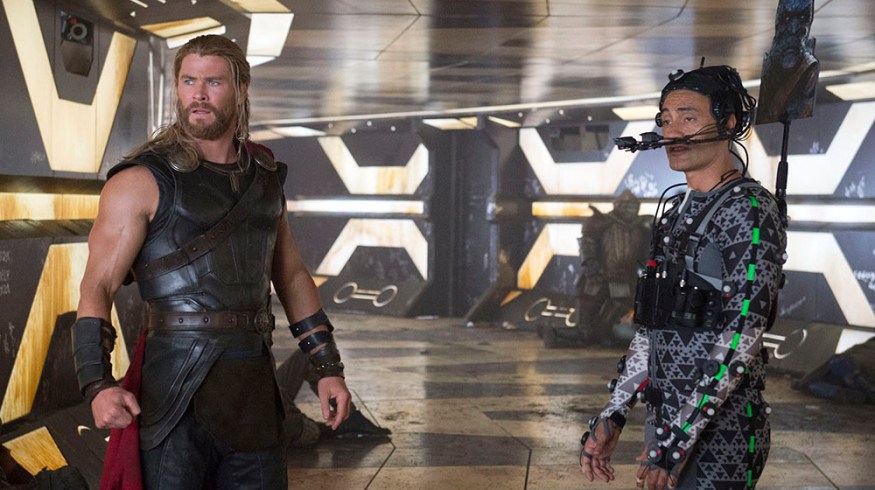
How the Team Behind Thor: Ragnarok Crafted an Epic Action Film
Let’s take a look at how the filmmakers behind Thor: Ragnarok demonstrate the power of collaboration when creating a movie.
Image via Disney/Jason Bolin.
It’s safe to say that Thor: Ragnarok was a massive success — in every way. The fans got what they wanted: a fresh, fun, entertaining take on a beloved character thanks to the filmmaking prowess of Taika Waititi. The film is making tons of money at the box office, and was a critical darling. So who is to take credit for an expensive Marvel monster such as this? The director? The DP? The star? In short, this project was a collective effort that relied on the creative sensibilities of truly talented editors, artists, and master filmmakers. Let’s take a look at what went into making the God of Thunder a fun time at the movies.
Editing
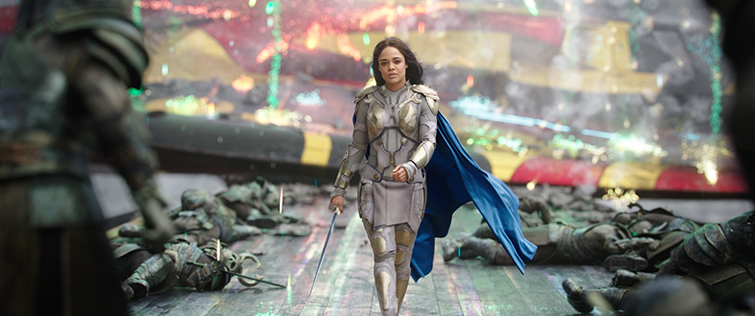
Image via Marvel.
To fill the role of Editor, Waititi, Victoria Alonso, and Jesse Torres picked an unlikely candidate: a traditionally comedy based duo, Zene Baker and Joel Negron. Having worked on past projects like Observe and Report, Pain and Gain, and Neighbors, the duo hadn’t yet tackled a Marvel movie. Given the light-hearted nature of the film, choosing these two made perfect sense for what Waititi and crew were going for. On the actual edit, Baker reflects on the freedom and workflow that came with the job, praising the collaborative efforts of his partner and the director.
Reflecting on the test-screening process, Baker fills us in on crucial information that editors should keep in mind:
You’re trying to make something with its own characteristics. But as you get into these types of movies, they’re invaluable, especially with the comedy aspect of it. You learn really quickly which jokes are gonna tank. There are some jokes that you hate that turn out to be gangbusters and you’re like, ‘Okay, so I’m not right about everything, and I’m not wrong about everything.’ I’ve reached the point now where, comedy wise, they’re invaluable. Story wise, you can get that diamond in the rough who’s like, ‘I don’t understand this story point,’ and if enough people say the same thing, you have to really examine it.
This tidbit is an excellent example of why you should trust your instincts, but understand that your first and final cut might still need revisions. Letting someone else take a look at your work is always a good way to reflect and change anything that doesn’t quite hit — regardless of the type of video you’re working on. Baker goes on to talk about the process of reshoots, and how going back to shoot more for your project doesn’t necessarily have to be a bad thing:
You want to make the best possible movie you can, and sometimes it requires additional photography. You can make a scene so much better with just one little thing. You can literally shoot for five minutes to make one scene aces, and then put a few days into another scene. We’re all carefully debating everything, throughout the process.
Visual Effects
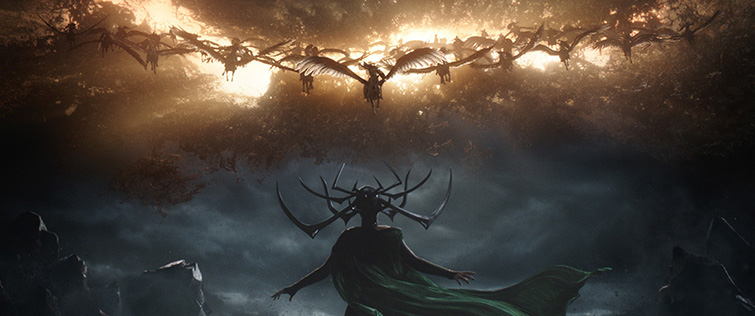
Image via Marvel.
Crafting the look and feel of the film was always going to be challenging due to the approach Marvel was taking with the re-vamped franchise. Along with the tone, editing, and writing, Taika and the lot knew they had to push the boundaries for visual effects and portraying action (after all, this is an action movie).
For a particularly stunning flashback scene, one of the film’s central characters rides into battle on a winged horse towards Hela, the Goddess of Death. The scene is a spectacular blend of slow-motion and visual and practical effects. To create the effect in the scene, Waititi’s own friend and fellow actor Stuart Rutherford and VFX artist Carlo Van de Roer designed a rig to move light at 10,000 feet per second, accurately capturing an image in 360 degrees like never before. In a recent interview with SYFY Wire, Van de Roer detailed the setup:
We shot with a Phantom Flex4K at about 1,000 frames a second, and what happens is you get this moment where time slows down to an incredible soup. You get into really thick, slo-mo action, but then, almost impossibly, the light actually does a full 360 degree loop around the actors in that moment.
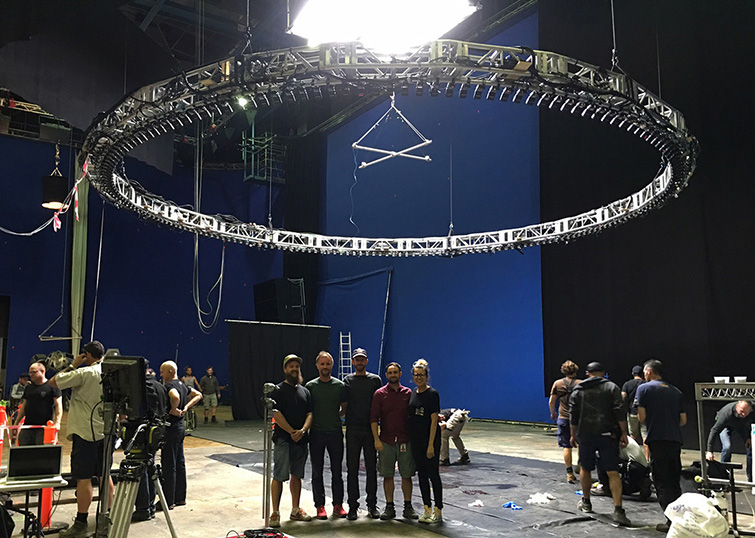
Image via SYFY Wire.
Another prime example of how Thor: Ragnarok approached its themes and story expertly is the blend of practical and visual effects into one seamless feeling of retro nostalgia mixed with a visually stunning space opera. You can see this in the design of Hela’s wardrobe. The headdress is the work of Ironhead Studios, and it is a perfect example of how to expertly blend practical, old-school costuming with new age effects — if you have the right vision and right team working together.
The headpiece is a modular, 3D-printed, to-scale prop that appears several times throughout the movie. If you’ve seen the movie, you’ll recall the helmet moving and shifting as Hela prepares for battle each time. So the costume blends practical effects and CGI.
While on set, the VFX team was well aware of Taika’s sensibilities regarding heavy VFX work, so they worked with his strengths and came up with a solution to get the most out of their indie director. Jake Morrison, the VFX supervisor, talked to Art of VFX about the film and explained the process:
It was clear that Taika wasn’t going to allow for an army of technicians to run in and reset mocap markers, camera, etc. after a take so myself and our VFX Producer, Cyndi Ochs, worked hard to make sure the technology was as invisible as possible to Taika. We even went so far as to build the motion capture cameras into the sets themselves to ensure that all of the performances happened together, rather than trying to capture one half of a performance on the set and then a second half in a separate motion capture volume.
There have been several interviews with the VFX artists at various studios behind Thor: Ragnarok that have provided some insane details about the creation of the world and the characters.
- Andrew Hellen – Method Studios
- Dave Hodgins – Digital Domain
- Kevin Souls & Raphael A. Pimentel – Luma Pictures
- Alexis Wajsbrot – Framestore
Directing
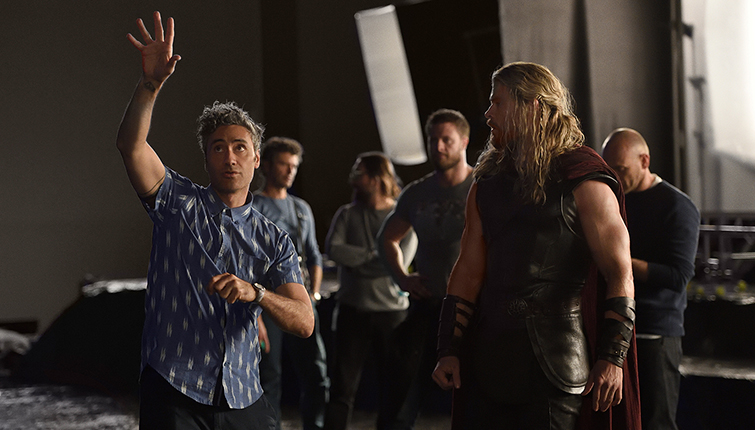
Image via Art of VFX.
The film’s indie-darling director, Taika Waititi, has brought us some classics already, from What We Do In The Shadows to Hunt for the Wilderpeople. While these are relatively smaller features, they feel grand in scope and demonstrate the indie filmmaker’s sensibilities for controlling tone with comedy and action. Waititi has said in interviews and late night bits that his method for pitching the Ragnarok role was to simply edit together a reel featuring various clips and stills to Led Zeppelin’s “Immigrant Song.” Well, it worked, and if you’ve seen the film, you know the decision to go with this aesthetic and song choice worked wonders. Waititi’s approach to filmmaking is both inspiring and motivating.
In this clip, Waititi breaks down the similarities and differences between shooting an independent feature and shooting a megaton superhero flick — with a little sarcasm thrown in. While shooting a standard conversation between Thor and Loki, Waititi describes the simple “lazy” setup and finding the balance between improvisation and sticking with the script. In regard to his directorial style, the New Zealand maestro gives us one last gem:
The direction I gave to them was to stand still and know your lines, and say them fast.
There you have it. The secret to directing a mega-blockbuster hit. But the charm doesn’t end there. The cast and crew have been interviewed and showcased all over the internet, and they have offered up plenty of incredible behind-the-scenes stories, as well as insights into the production. One of the many reasons the film has done as well as it has is partially due to the team behind the film praising the creative process and freedom they had while working on a film like this. The takeaway is this: whatever role you’re playing, be open to new ideas and new perspectives.
Lastly, I’ll leave this Academy conversation with Waititi and the film’s editor, composer, costume designer, and writer.





